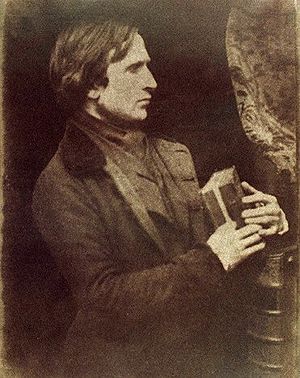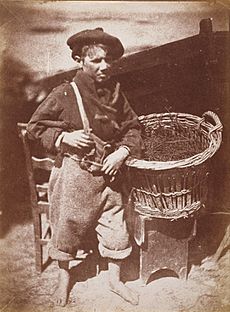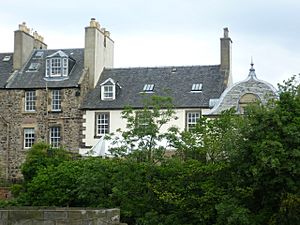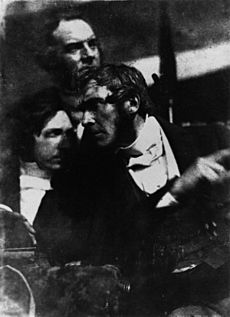Robert Adamson (photographer) facts for kids
Quick facts for kids
Robert Adamson
|
|
|---|---|

Robert Adamson
|
|
| Born | 26 April 1821 St Andrews, Scotland
|
| Died | 14 January 1848 (aged 26) St Andrews, Scotland
|
| Nationality | Scottish |
| Known for | Early pioneer of photography |
Robert Adamson (born April 26, 1821 – died January 14, 1848) was a Scottish chemist and a very early photographer. He is famous for his groundbreaking work with David Octavius Hill. Together, they created about 2500 calotypes (an early type of photograph) in just five years. Most of these were portraits of people.
Contents
Robert Adamson's Early Life
Robert Adamson was born in St Andrews, Scotland. He was one of ten children. His father, Alexander Adamson, was a farmer. Robert grew up in a place called Burnside.
He went to Madras College in St Andrews. There, he showed amazing talent in math and mechanics. He even won the math prize twice! From a young age, he worked in an engineering shop. He also trained to be a millwright, someone who builds and repairs mills.
Starting a Photography Career
Robert Adamson really wanted to be an engineer. However, he became ill, which led him to photography instead. His brother, John, taught him about calotype photography. The physicist David Brewster from the University of St Andrews also helped him learn. This was in the late 1830s.
Even in April 1839, people noticed Adamson's skills. Fox Talbot, who invented the calotype, said his pictures looked like "Rembrandtish" paintings. Robert's brother John, who was a doctor and lecturer, made the first calotype in Scotland in 1841.
Opening a Studio in Edinburgh

Young Robert Adamson opened his own photography studio. It was at Rock House in Edinburgh. He opened it on May 10, 1843.
In June, David Brewster suggested Adamson to David Octavius Hill. Hill was a painter known for his romantic Scottish landscapes. Hill hired Adamson, and they got a big job in 1843. They were asked to photograph 470 clergymen. These men had founded the Free Church of Scotland. Hill wanted these photos to help him paint a large group portrait. This painting, however, was not finished until 1866.
Working Together: Hill & Adamson
Adamson's studio was the first in Edinburgh to focus on calotypes. It was very private. Hill needed the calotypes to help with his paintings. Many important people came to be photographed by Hill and Adamson. In just a few years, they became very famous in the art world in Scotland.
Between 1843 and 1848, they took about 2500 portraits. Some people even say it was 3000 or more! They also took many pictures of Edinburgh. Their work was shown in exhibitions in 1844, 1845, and 1846. Their prints were sold at a gallery on Princes Street.
Hill and Adamson wanted to publish their work. They bought a special camera in 1844. But their plans to sell photo albums by subscription did not work out.
Famous Photographs and Subjects
Their photographs often had soft reddish-brown or sepia colors. They captured landscapes from Fife and city scenes. This included pictures of the Scott Monument while it was being built in Edinburgh.
They also took some amazing "action" photos of soldiers. One of their most famous pictures shows two priests walking side by side. Their photos of groups and children were truly special. They photographed not just famous people, but also everyday working folk. They especially liked photographing the fishermen of Newhaven and their wives.
Their series of photos about Newhaven fishing families was very important. It showed how people lived and connected in that community. This was their most notable work together.
By mid-1847, the studio stopped making new photos. This was because Robert Adamson's health was getting worse. He went back to St Andrews to recover with his family. Sadly, he died from tuberculosis on January 14, 1848. He was only 26 years old.
Legacy and Rediscovery
In 1851, the photographs by Hill & Adamson were shown at The Great Exhibition. After Adamson's death, Hill went back to painting. It wasn't until 1872 that their photographic work was rediscovered.
Later, some of their photos appeared in a magazine called Camera Work in 1905, 1912, and 1914. Their work was also shown in New York City. These exhibits were at Alfred Stieglitz's 291 Art Gallery and the National Arts Club.
Some of Robert Adamson's Works
- Miss Justine Munro
- Miss Grizzel Baillie, Scotland
- Mrs. Barbara (Johnstone) Flucker Opening Oysters
- Bringing in the catch
- Officer of the 92nd Gordon Highlanders Reading to the Troops, Edinburgh Castle
- The Fairy Tree at Colinton
- The Gowan
- The Minnow Pool
- The Rev. Dr. Jabez Bunting, Scotland
- Dumbarton Presbytery
- Willie Liston Redding the Line



